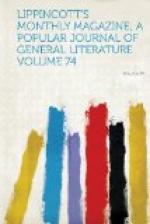Mr. Forbes’s visit to the Cocos-Keeling Islands, in the Indian Ocean, cannot be passed over. He was eager to visit a coral-reef, and this atoll, stocked and planted only by the flotsam and jetsam of the seas, the winds, and migrating birds, offers to the naturalist a most delightful study; for here, progressing almost under his eyes, are the phenomena which have made Bermuda and other coral groups. Little as the Keeling Islands seem to offer in the way of secure habitation, they have a population of some hundreds of people, presided over by their energetic proprietor, Mr. Ross, who has planted the atoll thickly with cocoanut palms. Gathering the nuts and expressing the oil is the chief industry of the inhabitants, who are all taught to work and support themselves in some useful way. No money is in circulation on the island: a system of exchange and barter with agents in Batavia for necessary products takes its place. This thriving little community has, however, terrible forces to contend against. Darwin recounts the effects of an earthquake which took place two years before his visit to the islands in 1836; a fierce cyclone brought ruin and devastation in 1862; and in 1876 a terrible experience of cyclone and earthquake almost swept away the whole settlement. This was followed by a most singular phenomenon. “About thirty-six hours after the cyclone,” writes Mr. Forbes, “the water on the eastern side of the lagoon was observed to be rising up from below of a dark color. The color was of an inky hue, and its smell ‘like that of rotten eggs.’ ... Within twenty-four hours every fish, coral, and mollusc in the part impregnated with this discoloring substance—probably hydrosulphuric or carbonic acid died. So great was the number of fish thrown on the beach, that it took three weeks of hard work to bury them in a vast trench dug in the sand.” Wherever this water touched the growing coral-reef, it was blighted and killed. Darwin saw similar “patches” of dead coral, and attributed them to some great fall of the tide which had left the insects exposed to the light of the sun. But it is probable that a similar submarine eruption had taken place after the earthquake which preceded his visit to the Keeling Islands in 1836.
“Birds in the Bush.”
By Bradford Torrey.
Boston: Houghton, Mifflin & Co.
We like the name of Mr. Torrey’s book, which seems to carry with it a practical reversal of the proverb that a bird in the hand is worth two in the bush. For although in many ways it is a good and pleasant sign to note the increase of amateur naturalists among us, we yet feel a dread of an incursion of those lovers of classified collections, “each with its Latin label on,” who believe that in gaining stuffed specimens they may best arrive at the charm and the mystery of that exquisite phenomenon which we call bird-life. Mr. Torrey has no puerile ambitions for birds in the hand, and a bird in the bush makes to his perception holy ground, where he takes the




